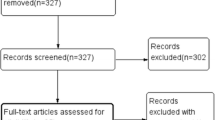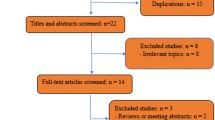Abstract
For the treatment of large upper urinary stones percutaneous nephrolithotomy (PCNL) is generally considered the first choice, and Laparoscopic Stone Surgery (LSS) is an alternative. We aim to compare the efficiency and safety of PCNL with LSS, as far as the management of large upper urinary stones is concerned. A systematic search from Pubmed, Web of Science, Wiley Online Library and Elsevier was performed up to August 1, 2015 for the relevant published studies. After data extraction and quality assessment, meta-analysis was performed using the RevMan 5.3 software. 15 eligible trials evaluating LSS vs. PCNL were identified including 6 prospective and 9 retrospective studies with 473 patients undergoing LSS and 523 patients undergoing PCNL. Although LSS led to longer operative time (p = 0.01) and higher open conversion rate (p = 0.02), patients might benefit from significantly fewer overall complications (p = 0.03), especially lower bleeding rate (p = 0.02), smaller drop in hemoglobin level (p < 0.001), less need of blood transfusion (p = 0.01). The stone free rate was also higher for LSS compared with PCNL (p < 0.001) with less secondary/complementary procedure (p = 0.006). There was no significant difference in other demographic parameters between the two groups. Our data suggests that LSS turns out to be a safe and feasible alternative to PCNL for large upper urinary stones with less bleeding and higher stone free rate. Because of the inherent limitations of the included studies, further large sample prospective, multi-centric studies and randomized control trials should be undertaken to confirm our findings.















Similar content being viewed by others
References
Lopez M, Hoppe B (2010) History, epidemiology and regional diversities of urolithiasis. Pediatr Nephrol 25:49–59
Hemal AK, Goel A, Kumar M, NP G (2001) Evaluation of laparoscopic retroperitoneal surgery in urinary stone disease. J Endourol 15:701–705
Kramer BA, Hammond L, Schwartz BF (2007) Laparoscopic pyelolithotomy: indications and technique. J Endourol 21:860–861
Desai RA, Assimos DG (2008) Role of laparoscopic stone surgery. Urology 71:578–580
Salvadó JA, Guzmán S, Trucco CA, CA P (2009) Laparoscopic pyelolithotomy: optimizing surgical technique. J Endourol 23:575–578
Simforoosh N, Aminsharifi A (2013) Laparoscopic management in stone disease. Curr Opin Urol 23:169–174
Türk C, Knoll T, Petrik A, Sarica K, Skolarikos A, Straub M, Seitz C (2015) Guidelines on Urolithiasis. European Association of Urology. http://uroweb.org/wp-content/uploads/EAU-Guidelines-Urolithiasis-2015-v2.pdf
Clarke M, Horton R (2001) Bringing it all together: lancet-Cochrane collaborate on systematic reviews. Lancet 357:1728
Hozo SP, Djulbegovic B, Hozo I (2005) Estimating the mean and variance from the median, range, and the size of a sample. BMC Med Res Methodol 5:13
Gaur DD, Punjani HM, Madhusudhana HR, Rathi SS (2001) Retroperitoneal laparoscopic pyelolithotomy: how does it compare with percutaneous nephrolithotomy for larger stones? Minim Invasive Ther Allied Technol 10:105–109
Goel A, AK H (2003) Evaluation of role of retroperitoneoscopic pyelolithotomy and its comparison with percutaneous nephrolithotripsy. Int Urol Nephrol 35:73–76
Meria P, Milcent S, Desgrandchamps F, Mongiat-Artus P, Duclos JM, Teillac P (2005) Management of pelvic stones larger than 20 mm: laparoscopic transperitoneal pyelolithotomy or percutaneous nephrolithotomy? Urol Int 75:322–326
Basiri A, Simforoosh N, Ziaee A, Shayaninasab H, Moghaddam SM, Zare S (2008) Retrograde, antegrade, and laparoscopic approaches for the management of large, proximal ureteral stones: a randomized clinical trial. J Endourol 22:2677–2680
Tepeler A, Binbay M, Sarı E, Akcay M, Berberoglu Y, Ahmet Yaser AY, AH AH (2009) The comparison of laparoscopic pyelolithotomy versus percutaneous nephrolithotomy in the management of large renal pelvic stones. Eur Urol 8:261
Al-Hunayan A, Khalil M, Hassabo M, Hanafi A, Abdul-Halim H (2011) Management of solitary renal pelvic stone: laparoscopic retroperitoneal pyelolithotomy versus percutaneous nephrolithotomy. J Endourol 25:975–978
Tefekli A, Tepeler A, Akman T, Akcay M, Baykal M, Karadag MA, Muslumanoglu AY, de la Rosette J (2012) The comparison of laparoscopic pyelolithotomy and percutaneous nephrolithotomy in the treatment of solitary large renal pelvic stones. Urol Res 40:549–555
Aminsharifi A, Hosseini MM, Khakbaz A (2013) Laparoscopic pyelolithotomy versus percutaneous nephrolithotomy for a solitary renal pelvis stone larger than 3 cm: a prospective cohort study. Urolithiasis 41:493–497
Haggag YM, Morsy G, Badr MM, Al Emam AB, Farid M, Etafy M (2013) Comparative study of laparoscopic pyelolithotomy versus percutaneous nephrolithotomy in the management of large renal pelvic stones. Can Urol Assoc J 7:E171–E175
Liu Y, Zhou Z, Xia A, Dai H, Guo L, Zheng J (2013) Clinical observation of different minimally invasive surgeries for the treatment of impacted upper ureteral calculi Pakistan. J Med Sci 29:1358–1362
Li S, Liu TZ, Wang XH, Zeng XT, Zeng G, Yang ZH, Weng H, Meng Z, Huang JY (2014) Randomized controlled trial comparing retroperitoneal laparoscopic pyelolithotomy versus percutaneous nephrolithotomy for the treatment of large renal pelvic calculi: a pilot study. J Endourol 28:946–950
Singh V, Sinha RJ, Gupta DK, Pandey M (2014) Prospective randomized comparison of retroperitoneoscopic pyelolithotomy versus percutaneous nephrolithotomy for solitary large pelvic kidney stones. Urol Int 92:392–395
Zhu H, Ye X, Xiao X, Chen X, Zhang Q, Wang H (2014) Retrograde, antegrade, and laparoscopic approaches to the management of large upper ureteral stones after shockwave lithotripsy failure: a four-year retrospective study. J Endourol 28:100–103
Perlin Dmitry, Alexandrov Ilia, Zipunnikov Vasily, Kargin K (2011) Laparoscopic retroperitoneal pyelolithotomy for management of solitary renal stones: our experience. J Endourol 25:336
Basiri A, Tabibi A, Nouralizadeh A, Arab D, Rezaeetalab GH, Hosseini Sharifi SH, MH S (2014) Comparison of safety and efficacy of laparoscopic pyelolithotomy versus percutaneous nephrolithotomy in patients with renal pelvic stones: a randomized clinical trial. Urol J 11:1932–1937
Patel SR, Nakada SY (2014) The modern history and evolution of percutaneous nephrolithotomy. J Endourol 29:153–157
Michel MS, Trojan L, Rassweiler JJ (2007) Complications in percutaneous nephrolithotomy. European urology 51:899–906 (discussion 906)
Wang X, Li S, Liu T, Guo Y, Yang Z (2013) Laparoscopic pyelolithotomy compared to percutaneous nephrolithotomy as surgical management for large renal pelvic calculi: a meta-analysis. J Urol 190:888–893
Author information
Authors and Affiliations
Corresponding author
Ethics declarations
Conflict of interest
All the authors declare that they have no conflict of interest.
Ethical standard
This article does not contain any studies with human participants or animals performed by any of the authors.
Funding
This study was funded by National Natural Science Foundation of China (CN) 81170650.
Additional information
C. Zhao and H. Yang contributed equally to this work.
Rights and permissions
About this article
Cite this article
Zhao, C., Yang, H., Tang, K. et al. Comparison of laparoscopic stone surgery and percutaneous nephrolithotomy in the management of large upper urinary stones: a meta-analysis. Urolithiasis 44, 479–490 (2016). https://doi.org/10.1007/s00240-016-0862-0
Received:
Accepted:
Published:
Issue Date:
DOI: https://doi.org/10.1007/s00240-016-0862-0




